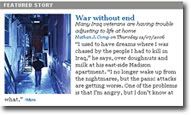 Posttraumatic stress disorder continues to get some much-needed national media attention. Monday's Hardball is the latest example. Host Chris Matthews opened the the segment with the story of Marine Lance Corporal Blake Miller, an Iraq veteran who received international notoriety when a photograph snapped of him in Fallujah was printed far and wide. He's now returned to the states, and is coping with PTSD.
Posttraumatic stress disorder continues to get some much-needed national media attention. Monday's Hardball is the latest example. Host Chris Matthews opened the the segment with the story of Marine Lance Corporal Blake Miller, an Iraq veteran who received international notoriety when a photograph snapped of him in Fallujah was printed far and wide. He's now returned to the states, and is coping with PTSD.
Click on 'Article Link' below tags for more...
From the Hardball transcript (scroll down 2/3 of the page):
MATTHEWS: Welcome back to HARDBALL. For many American troops fighting in Iraq and Afghanistan, getting home is only half the battle. Once back with their family and friends, they face the new challenge of coping with their sometimes traumatizing memories of war, the condition known as post traumatic stress disorder or PTSD. MSNBC‘s Norah O‘Donnell has more. (BEGIN VIDEOTAPE)
NORAH O‘DONNELL, MSNBC CHIEF WASHINGTON CORRESPONDENT (voice-over):
Remember this picture? It is one of the most iconic images from the Iraq war. Marine Lance Corporal Blake Miller went from Fallujah to the front pages of newspapers and was called The Marlboro Man. Now, almost two years later, Miller is at home in Kentucky a changed man.
BLAKE MILLER, ‘MARLBORO MARINE‘: You can put something aside, but as far as trying to forget it, it doesn‘t work.
O‘DONNELL: Miller now suffers from post traumatic stress disorder or PTSD.
Miller is 21, honorably discharged, and can't find employment. He's having trouble sleeping, he's bogged down by nervous ticks and an aversion to crowds. The video piece closed with comments made by Charles Engle, a Walter Reed psychiatrist, and Jay Nicholson, Secretary of Veterans Affairs stating that the VA is taking care of the needs of our returning veterans.
Following O'Donnell's opening report, Chris Matthews introduces his guests: Gordon Mansfield, deputy secretary for Veterans Affairs, and General Barry McCaffrey. Before he begins the debate in the studio, he asks O'Donnell the following question:
MATTHEWS: Norah, is there any deniers out there who say there‘s no such thing as PTSD?
O‘DONNELL: I did not speak to any who believe there is, because in every war from the Civil War, it was called soldier‘s heart, after Vietnam, it was called shell shock, and now we have this more clinical term called post traumatic stress disorder. So we know many our soldiers throughout America‘s history have suffered from some sort of mental illness, but of course all mental illness has been difficult to talk about until recently.
Blake Miller spoke to us, this very heroic soldier, because he says that by speaking out he hopes that other troops will feel more comfortable talking about some of the problems they‘re experiencing and there is help available from Veterans Affairs.
He asks the same question of his guests:
MATTHEWS: Mr. Secretary, thank you for joining us. Just to repeat the question, there‘s no doubt this exists?
GORDON MANSFIELD, DEPUTY SECRETARY OF VETERANS AFFAIRS: There‘s no doubt in my mind or in the V.A.‘s mind that it does exist.
Perhaps someone needs to tell Oliver North, or Sally Satel, MD, or Christina Hoff Sommers, or Mackubin T. Owens, or George F. Will, or...oh, you get the picture. PTSD is a political and financial liability, so there are a lot of people who might rather gloss over it.
Back to Hardball:
MATTHEWS: General McCaffrey, I was struck by the difficulty that soldier had, The Marlboro Man they called him, who appeared with the cigarette in that famous picture, talking about the casualties he inflicted. You‘ve been in a lot of combat. Is that something you‘ve seen from your fellow troops?
GEN. BARRY MCCAFFREY, U.S. ARMY (RET): Well, you know, first of all, let me start off by saying, there‘s no question that this PTSD is real. We‘ve always known you can take soldiers, Marines, push them over the edge.
A lot of artillery mortar fire, extreme cold, malnutrition, extreme heat. Don‘t tell them when they‘re going to come home from combat. There‘s all sorts of reasons why any combat soldier can reach his limit.
This young Marine obviously saw a lot of heavy combat. Having said that, Chris, let me just offer a balancing viewpoint. Most young soldiers and Marines that fought in heavy combat like Fallujah, as much fighting as we‘ve done since for God‘s sakes Aurora Pocket. That was high intensity battle. Most of them come home strengthened by it, not weakened. They‘re grateful for the comradeship, the valor of their fellow soldiers and Marines. They are grateful for hot water at night, grateful for freedom and safety here in America. Most of them aren‘t damaged by this experience.
MATTHEWS: Mr. Secretary, can you be that positive?
MANSFIELD: I would...
MATTHEWS: That combat doesn‘t generally hurt a person‘s psyche.
GORDON: Well, combat is not the ordinary way of life. It‘s an uncommon situation. So the question is what happens in that uncommon situation? What happens with the camaraderie of the unit that person serves in? And how that person is returned to the United States and how they can adapt to being back in the United States.
MATTHEWS: But all the guys that came back from World War II—you know, you talk about Tom Brokaw and the greatest generation. All of these guys came back, and I grew up with them as friends of mine—or father‘s of friends of mine. You know, Knights of Columbus guys, regular guys. And only later did I realize that these guys had been to hell and back, so many of them.
And they seem to be totally normal. They had a beer and a cigarette. They raised a family. They seemed to enjoy life, turned on the tube at night, watch Phil Silvers. You know, they seem to enjoy life, so many of them.
MANSFIELD: Your correspondent referred though to the term of shell shock and combat fatigue, and those two terms come out of basically World War I and World War II. And really I think they mean almost the same thing as PTSD means.
MATTHEWS: But they‘re the odd case or the familiar case?
MANSFIELD: Well, right now if you look at the total number of troops that have been in Iraq, that total is around 500,000. Out of that 500,000, we in the V.A. have seen about 145,000.
MATTHEWS: A third.
MANSFIELD: And out of those, 20,638 are being treated right now for PTSD or mental health problems. So that‘s 14 percent or 15 percent of the lesser number.
The Deputy Secretary, who was entirely sympathetic in my view, went on to explain some of what the VA is doing to help these thousands who are in need of help. Mental health assessments of all troops when they return home, as well as 6 months later (this new review, the PDHRA, has only recently been implemented), etc.
Now, it's nitpicking time. The problem I had with the Hardball segment was the choice of guests:
- We had an official advocating for the VA.
- We had an official advocating the hardline military 'rah-rah' view.
- We had the pro-Bush administration host.
- Anyone missing from this picture?
Why was there not a chair at the table for a representative from Veterans for Common Sense or any other veterans organization -- even someone from the more traditional/conservative AMVETS or American Legion?
Could the producers of Hardball not find anyone who directly represents and advocates solely for the veterans to sit at the table?

Related Posts

 Jackie Eckhart of the Virginian-Pilot is one of the lucky few to have had the opportunity to review a copy of a free comic book, "Coming Home: What to Expect, How to Deal When You Return from Combat," now being offered to service members at
Jackie Eckhart of the Virginian-Pilot is one of the lucky few to have had the opportunity to review a copy of a free comic book, "Coming Home: What to Expect, How to Deal When You Return from Combat," now being offered to service members at  The always informative Lisa Chedekel
The always informative Lisa Chedekel 
 Today's Omaha World-Herald
Today's Omaha World-Herald 
 Alison Walker-Baird of Maryland's
Alison Walker-Baird of Maryland's 
 Another collection of news and commentary on issues important to veterans and their families -- especially those coping with PTSD.
Another collection of news and commentary on issues important to veterans and their families -- especially those coping with PTSD.



